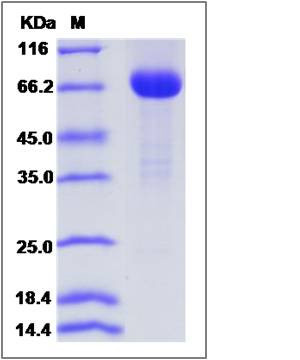Mouse FSTL1 Protein (Fc Tag)
AI316791,AW107808,Fstl,TSC-36
- 100ug (NPP1291) Please inquiry
| Catalog Number | P51127-M02H |
|---|---|
| Organism Species | Mouse |
| Host | Human Cells |
| Synonyms | AI316791,AW107808,Fstl,TSC-36 |
| Molecular Weight | The recombinant mouse FSTL1 comprises 529 amino acids and has a predicted molecular mass of 59.5 kDa. The apparent molecular mass of the protein is approximately 69 kDa in SDS-PAGE under reducing conditions. |
| predicted N | Glu 19 |
| SDS-PAGE |  |
| Purity | > 95 % as determined by SDS-PAGE |
| Protein Construction | A DNA sequence encoding the mouse FSTL1 (NP_032073.2) (Met1-Ile306) was expressed with the Fc region of human IgG1 at the C-terminus. |
| Bio-activity | |
| Research Area | Cancer |Cancer immunology |Cytokine & Receptor |Transforming Growth Factor Beta (TGF-beta) Superfamily |TGF-beta Superfamily Modulators |
| Formulation | Lyophilized from sterile PBS, pH 7.4. 1. Normally 5 % - 8 % trehalose and mannitol are added as protectants before lyophilization. Specific concentrations are included in the hardcopy of COA. |
| Background | Follistatin-related protein 1 (FSTL1) is an extracellular glycoprotein whose functional significance in physiological and pathological processes is incompletely understood. Recently, we have shown that FSTL1 acts as a muscle-derived secreted factor that is up-regulated by Akt activation and ischemic stress and that FSTL1 exerts favorable actions on the heart and vasculature. Here, we sought to identify the receptor that mediates the cellular actions of FSTL1. It contains an FS module, a follistatin-like sequence containing 10 conserved cysteine residues. FSTL1 is thought to be an autoantigen associated with rheumatoid arthritis. DIP2A functions as a novel receptor that mediates the cardiovascular protective effects of FSTL1. Experiment results have provided in vivo and in vitro evidence to demonstrate that Fstl1 modulates lung development and alveolar maturation, in part, through BMP4 signaling. |
| Reference |
